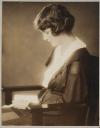
Mary Elizabeth Kathleen Dulcie Deamer
Born in December 13, 1890 / Died in August 16, 1972 / New Zealand / English
Biography
Mary Elizabeth Kathleen Dulcie Deamer (1890-1972), writer and Bohemian, was born on 13 December 1890 at Christchurch, New Zealand, daughter of George Edwin Deamer, a physician from Lincolnshire, and his New Zealand-born wife Mable, née Reader. She was taught at home by her mother, who had been a governess. At 9 Dulcie appeared on the stage as a child with Robert Brough's Comedy Company. About 1902 the family moved to Featherston in the North Island. Later she was sent to friends in Wellington for elocution and ballet lessons as stage-training.
In 1907 Dulcie won first prize in a Lone Hand competition with a 'highly imaginative' Stone Age story: Norman Lindsay's illustrations shocked her family. Later Dulcie admitted: 'Even at that tender age I loved blood, murder and violence'. Next year she joined a touring theatrical company and met 32-year-old Albert Goldberg (d.1934), known as Goldie, who was working for J. C. Williamson. In the Roman Catholic Cathedral, Perth, she married him on 26 August 1908. They left at once for a tour of the Far East with Hugh Ward's company. She played small parts and sought copy for Lone Hand. In Sydney in December 1910 she reported the Billy Papke-Dave Smith fight for its promoter Hugh Donald McIntosh.
In the crowded years 1908-1924 Dulcie bore six children (two sons died in infancy), travelled overseas in 1912, 1913-14, 1916-19 and 1921 and published a collection of short stories and four novels?The Suttee of Safa (New York, 1913) 'a hot and strong love story about Akbar the Great'; Revelation (London, 1921) and The Street of the Gazelle (London, 1922), set in Jerusalem at the time of Christ; and The Devil's Saint (London, 1924). Three were syndicated in Randolph Hearst's newspapers in the United States of America. Her themes, including witchcraft, gave 'free play to the lavish style of her writing, displaying opulence and sensuality or squalor of traditional scenes'.
Her parents had moved to Sydney and Dulcie left her children with her mother to bring up. After she and her husband had separated in 1922 she lived at Kings Cross. As a freelance journalist she contributed stories, articles and verse to the Australian Woman's Mirror, other journals and newspapers, such as the Bulletin and the Sydney Morning Herald, often using pseudonyms. She was a founder in 1929 and committee-member of the Fellowship of Australian Writers. From 1930 she received a £52 pension from the Commonwealth Literary Fund.
Dulcie Deamer mixed with the 'starving artists, poor musicians, writers scratching for a living, bit actors, and people with all sorts of strange jobs', who met at Sam Rosa's restaurant and 'Theo's Club' where they crowned her 'Queen of Bohemia' on 13 July 1925. She often appeared in her famous leopard skin which she had first worn at the Artists' Ball on 27 September 1923. With a dash of Spanish blood, she was small and slight with 'jewel-bright' dark eyes and long flowing black hair. Zora Cross described her in 1928 as 'Speedy as a swallow in movement, quick as sunlight in speech ? [and] restless as the sea'. Full of joie de vivre, she enlivened many a party by doing the splits and dancing the hula-hula.
In the 1930s Dulcie Deamer wrote plays; several were produced at the Tom Thumb Theatre, and That by which Men Live (1936) and Victory (1938) at Beryl Bryant's Playhouse. The Sydney Morning Herald theatre critic found her a 'playwright of powerful imagination'. She also published another novel, Holiday, dealing with the persecution of early Christians, in 1940, and two volumes of mystical poetry, Messalina (1932) and The Silver Branch (1948).
For Dulcie Deamer and her friends, 'the Cross' was never the same after the influx of American servicemen in World War II and the burgeoning of shops, cafés and neon lights. In the 1960s she wrote her autobiography, 'The golden decade', but it was never published. On 16 August 1972 she died in the Little Sisters of the Poor home, Randwick, and was buried with Catholic rites in Botany cemetery. She was survived by a son and daughter; her son Christopher was drowned when H.M.A.S. Parramatta was torpedoed off Tobruk in November 1941. Her portrait was painted in London about 1921 by Helen Donald-Smith. ..





